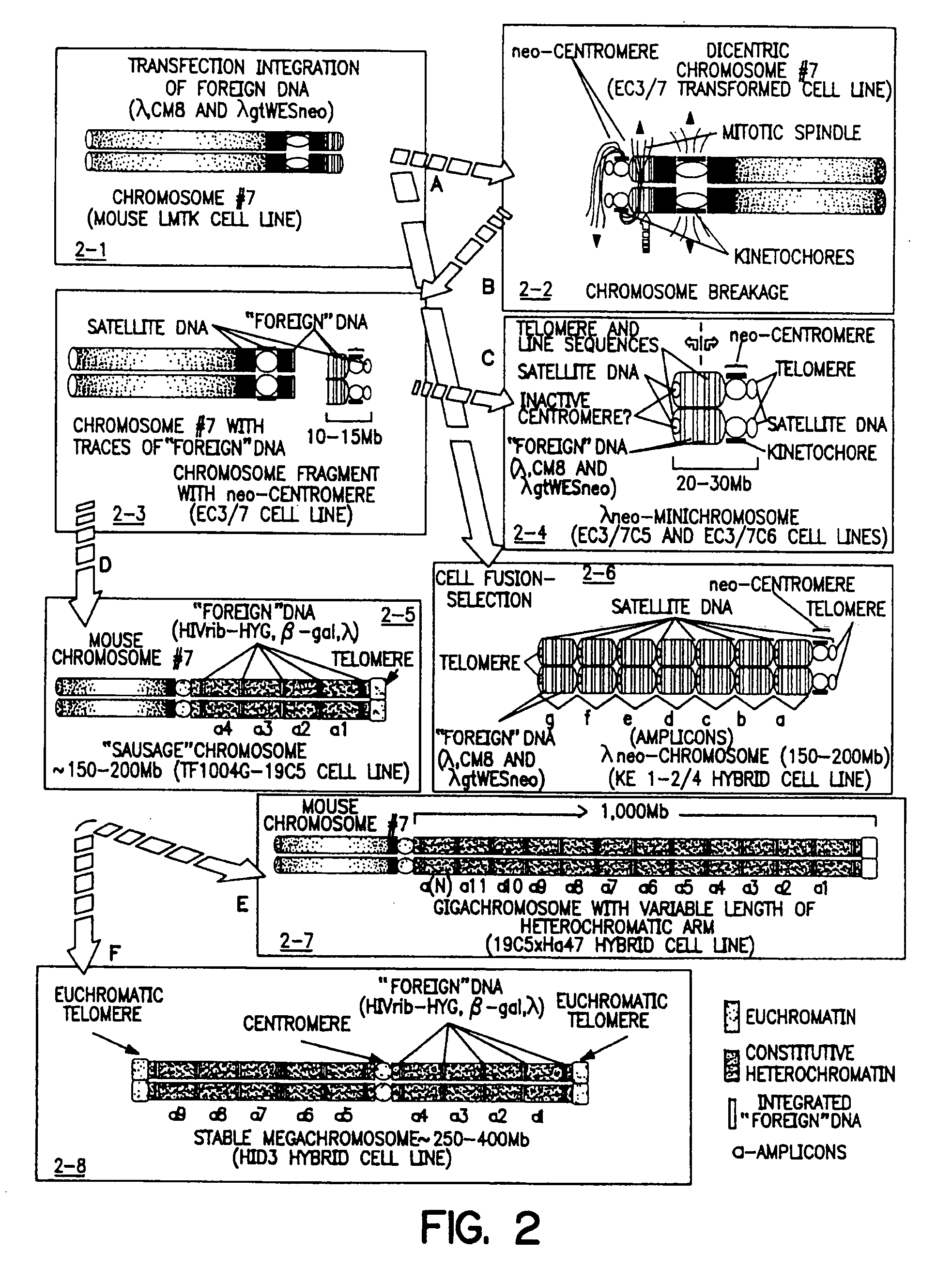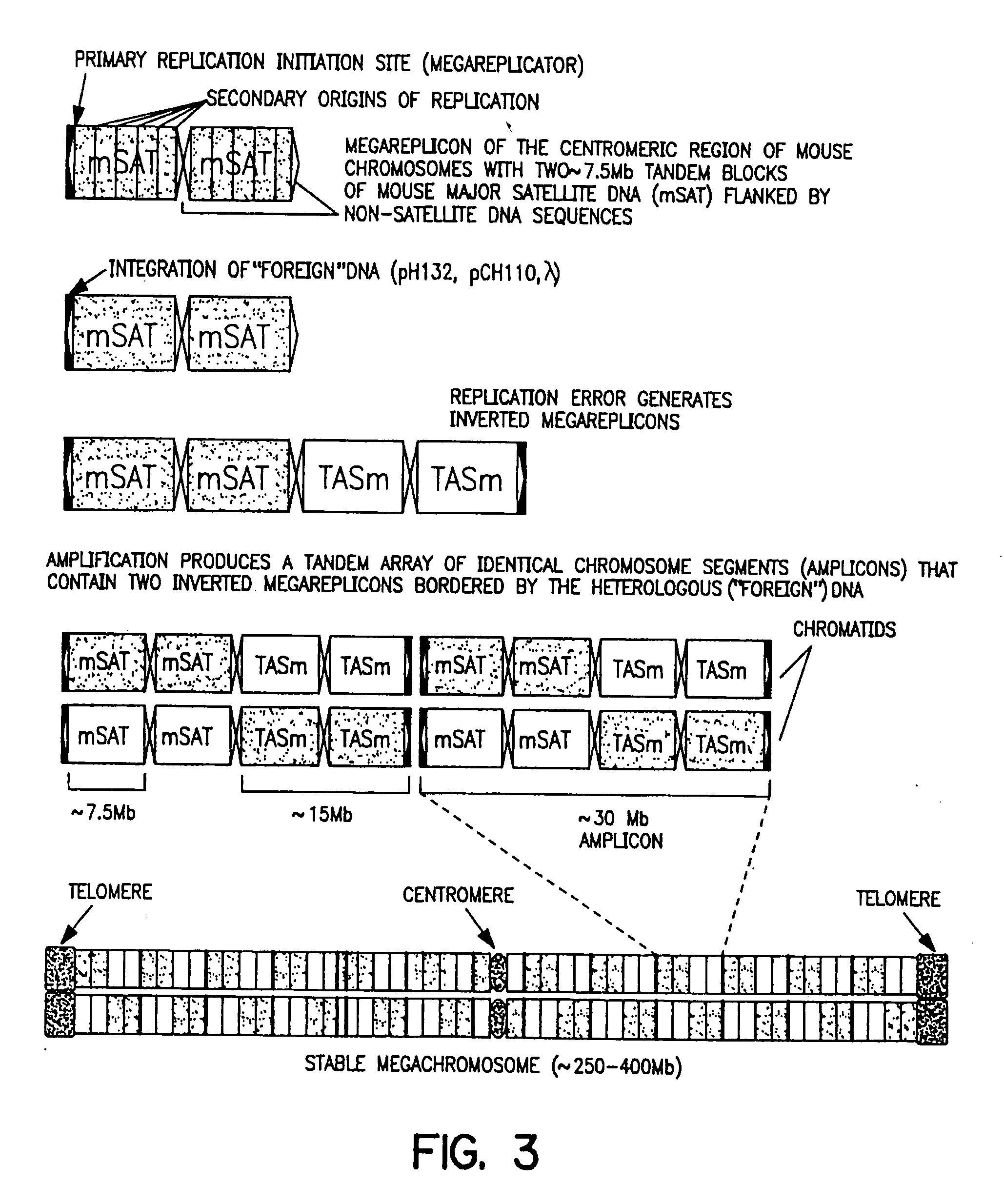Artificial chromosomes, uses thereof and methods for preparing artificial chromosomes
a technology of artificial chromosomes and chromosomes, which is applied in the field of methods for preparing artificial chromosomes, can solve the problems of numerous limitations of the current system, the risk of disruption, and the inability of the available vector to meet all these requirements, and achieve the effect of stable chromosomal vectors, small stable self-replicating artificial chromosomes, and reduced macs
- Summary
- Abstract
- Description
- Claims
- Application Information
AI Technical Summary
Benefits of technology
Problems solved by technology
Method used
Image
Examples
example 1
General Materials and Methods
[0254] The following materials and methods are exemplary of methods that are used in the following Examples and that can be used to prepare cell lines containing artificial chromosomes. Other suitable materials and methods known to those of skill in the art may used. Modifications of these materials and methods known to those of skill in the art may also be employed.
[0255] A. Culture of Cell Lines, Cell Fusion, and Transfection of Cells [0256] 1. Chinese hamster K-20 cells and mouse A9 fibroblast cells were cultured in F-12 medium. EC3 / 7 (see, U.S. Pat. No. 5,288,625, and deposited at the European Collection of Animal cell Culture (ECACC) under accession no. 90051001; see, also Hadlaczky et al. (1991) Proc. Natl. Acad. Sci. U.S.A. 88:8106-8110 and U.S. application Ser. No. 08 / 375,271) and EC3 / 7C5 (see, U.S. Pat. No. 5,288,625 and Praznovszky et al. (1991) Proc. Natl. Acad. Sci. U.S.A. 88:11042-11046) mouse cell lines, and the KE1-2 / 4 hybrid cell line ...
example 2
Preparation of EC3 / 7, EC3 / 7C5 and Related Cell Lines
[0283] The EC3 / 7 cell line is an LMTK− mouse cell line that contains the neo-centromere. The EC3 / 7C5 cell line is a single-cell subclone of EC3 / 7 that contains the neo-minichromosome.
[0284] A. EC3 / 7 Cell Line
[0285] As described in U.S. Pat. No. 5,288,625 (see, also Praznovszky et al. (1991) Proc. Natl. Acad. Sci. U.S.A. 88:11042-11046 and Hadlaczky et al. (1991) Proc. Natl. Acad. Sci. U.S.A. 88:8106-8110) de novo centromere formation occurs in a transformed mouse LMTK− fibroblast cell line (EC3 / 7) after cointegration of λ constructs (λCM8 and λgtWESneo) carrying human and bacterial DNA.
[0286] By cotransfection of a 14 kb human DNA fragment cloned in λ (λCM8) and a dominant marker gene (λgtWESneo), a selectable centromere linked to a dominant marker gene (neo-centromere) was formed in mouse LMTK− cell line EC3 / 7 (Hadlaczky et al. (1991) Proc. Natl. Acad. Sci. U.S.A. 88:8106-8110, see FIG. 1).
[0287] Integration of the heterolog...
example 3
Minichromosome Transfer and Production of the λ-Neo-Chromosome
[0307] A. Minichromosome Transfer
[0308] The neo-minichromosome (referred to as MMCneo, FIG. 2C) has been used for gene transfer by fusion of minichromosome-containing cells (EC3 / 7C5 or EC3 / 7C6) with different mammalian cells, including hamster and human. Thirty-seven stable hybrid cell lines have been produced. All established hybrid cell lines proved to be true hybrids as evidenced by in situ hybridization using biotinylated human, and hamster genomic, or pMCPE1.51 mouse long interspersed repeated DNA probes for “chromosome painting”. The MMCneo has also been successfully transferred into mouse A9, L929 and pluripotent F9 teratocarcinoma cells by fusion of microcells derived from EC3 / 7C5 cells. Transfer was confirmed by PCR, Southern blotting and in situ hybridization with minichromosome-specific probes. The cytogenetic analysis confirmed that, as expected for microcell fusion, a few cells (1-5%) received (or retained...
PUM
| Property | Measurement | Unit |
|---|---|---|
| melting temperatures | aaaaa | aaaaa |
| temperature | aaaaa | aaaaa |
| temperature | aaaaa | aaaaa |
Abstract
Description
Claims
Application Information
 Login to View More
Login to View More - R&D
- Intellectual Property
- Life Sciences
- Materials
- Tech Scout
- Unparalleled Data Quality
- Higher Quality Content
- 60% Fewer Hallucinations
Browse by: Latest US Patents, China's latest patents, Technical Efficacy Thesaurus, Application Domain, Technology Topic, Popular Technical Reports.
© 2025 PatSnap. All rights reserved.Legal|Privacy policy|Modern Slavery Act Transparency Statement|Sitemap|About US| Contact US: help@patsnap.com



